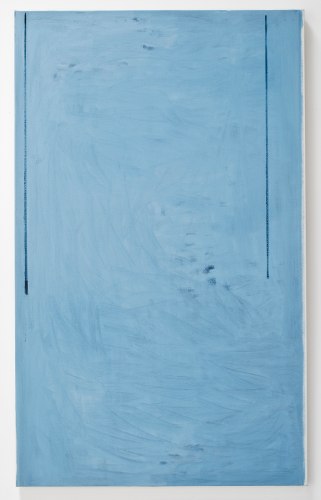
Summer Still (The Same Shadow), 2014, oil on linen, 72 x 44 inches (182.9 x 111.8 cm)
Art reviews: John Zurier in Berkeley
By Kenneth Baker
October 31, 2014
The Berkeley Art Museum’s curators have set the light level noonday high in a large gallery devoted to a solo show of Bay Area painter John Zurier, No. 255 in the institution’s long-running Matrix series.
The brightness favors various paintings whose dark tonalities will not disclose their details under light any less intense. It also serves as a cue, which too few visitors may recognize, that these works demand extraordinary scrutiny.
If no one has yet anointed Zurier a “painter’s painter,” someone inevitably will. It sounds like a compliment, like praise of a restaurant that chefs frequent after hours, but people tend to read it as a caution that something forbiddingly esoteric awaits them.
In fact, Zurier’s paintings present themselves as disarmingly open to dismissal — as possibly self-involved, lacking in discernible content, fatally indifferent to reception.
The thought of self-involvement cuts closest to relevant response because, deliberately or not, it recognizes Zurier’s process of observing and responding to the fine material and expressive details of each painting as it evolves.
The dimensions of a working surface, its texture — from light or heavy linen to coarse jute — the way the fabric weave takes an oil color or distemper, and the atmospherics of an emergent picture space — all these qualities may get overlooked or considered arbitrary by viewers in a hurry or liable to confuse looking with scanning. But they are at the center of Zurier’s attention as he works, along with memories and observations of light and landscape, particularly those of Iceland, where he has worked for some portion of each year lately.
The care given at the BAM to the placement and sequence of Zurier’s paintings, undoubtedly with his involvement, gives visitors another sort of prompting to bear down on the works’ material specifics.
The overriding question the paintings pose, though, is whether we can slow down to the tempo of observation that they set.
Underlying the adventures of Zurier’s hand, his eye for color and other constructive obsessions is an education in art that surfaces in details and affinities he probably does not track consciously.
He may not have thought of Matisse when painting the teal green band that laps across fog-gray “Finnbogi” (2014), but to the mind of anyone who knows the French master’s work, it will recall Matisse’s “Shaft of Sunlight, The Woods of Trivaux” (1917).
Similarly, Zurier may not have studied the sparely punctuated color fields of Raoul De Keyser (1930-2012), but Zurier’s “Héraðsdalur 13 (Avalanche)” (2014) and “Icelandic Painting (12 Drops)” (2012) seem to transmit echoes of them.
Possible allusions to artists as diverse as Barnett Newman, Edvard Munch and Robert Motherwell also drift through this selection of Zurier’s work, signs not of homage or influence but of a prodigious knack of internalizing painters’ ambitions in which Zurier’s art silently offers to initiate us.
Kenneth Baker is The San Francisco Chronicle’s art critic.